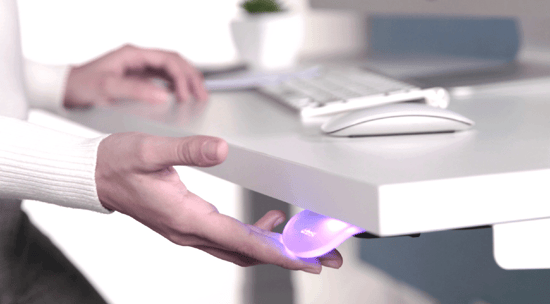White or Yellow Light: Which is Best for Lighting an Office?
The lighting in an office is a fundamental aspect that can affect both the work environment and employee productivity. When it comes to choosing the right type of light, questions arise: Should you opt for a white or yellow light? Which option is better? In this article, we will explore the characteristics of both options and help you decide which is most suitable for illuminating your office.
White Light: A Bright and Energizing Option

White light, also known as cool light, is characterized by having a higher color temperature, similar to daylight. This type of lighting is known for being bright, energizing, and stimulating. White light is ideal for work areas where a high level of concentration and attention is required, such as meeting rooms, individual workspaces, and reading areas. Additionally, it is excellent for enhancing colors and object details, which can be beneficial for certain creative or precision-oriented tasks.
Yellow Light: A Warm and Relaxing Ambience

Yellow light, also known as warm light, has a lower color temperature and provides a cozy and relaxing atmosphere. This type of lighting is ideal for break areas, informal meeting rooms, and spaces where a more relaxed ambiance is desired. Yellow light is soft and less intense, which can help reduce eye fatigue and create a sense of calm in the workspace. It is also perfect for creating a welcoming atmosphere in reception areas or waiting rooms.
Which Option Is Best for Your Office?
The choice between white and yellow lights will depend on the specific needs and goals of your office. Some factors to consider are:
1. Activities performed: If your team is primarily engaged in tasks that require concentration and detailed visual attention, such as graphic design or data analysis, white light may be more suitable. On the other hand, if you want to create a relaxed environment or promote social interaction in certain areas of the office, yellow light may be the ideal option.
2. Visual comfort: It is important to consider the visual comfort of your employees. Some individuals may feel more comfortable with white light, while others prefer yellow light. If possible, you can offer adjustable lighting options so that each employee can adjust it according to their preferences.
3. Aesthetics and design: The choice of light type should also take into account the overall design and aesthetics of your office. White light tends to give a sense of modernity and cleanliness, while yellow light can create a cozier and more traditional ambiance.
Regarding LED lamps for offices, they offer the advantage of being highly energy-efficient and durable. Additionally, many LED lamp models allow you to adjust the color temperature, giving you the flexibility to adapt the lighting to your specific needs.
Smart Lighting Systems for Modern Offices
Modern office environments are increasingly adopting smart lighting systems, moving beyond simple on/off switches to dynamic, responsive illumination that enhances productivity, well-being, and energy efficiency. These intelligent systems leverage advanced sensors, connectivity, and automation to adapt lighting conditions to various factors, such as the time of day, the specific task being performed, or even individual user preferences. For instance, circadian lighting systems mimic the natural light cycle, providing cooler, brighter light in the morning to boost alertness and gradually shifting to warmer, softer tones in the afternoon to support natural sleep patterns. This alignment with the body's natural rhythms can significantly improve employee mood, reduce eye strain, and enhance overall health.
Beyond circadian benefits, smart lighting offers substantial energy savings. Occupancy sensors can automatically dim or turn off lights in unoccupied areas, while daylight harvesting sensors adjust artificial light levels based on the amount of natural light available, ensuring optimal illumination without waste. Integration with building management systems allows for centralized control and data analytics, providing insights into energy consumption and space utilization. Employees can often personalize their lighting settings via mobile apps or desktop controls, creating a tailored work environment that suits their individual needs and preferences. This level of customization not only contributes to a more comfortable and productive workspace but also empowers employees, fostering a sense of control over their immediate surroundings. Smart lighting is thus a key component of the intelligent, human-centric office of the future.
Impact of Lighting on Well-being and Work Productivity
The profound impact of lighting on human well-being and work productivity in office settings is a subject of growing scientific interest. Beyond simply illuminating a space, the quality and type of lighting can significantly influence an employee's mood, cognitive function, visual comfort, and even long-term health. Poor lighting, characterized by glare, flicker, or insufficient illumination, can lead to eye strain, headaches, and fatigue, directly hindering concentration and efficiency. Conversely, well-designed lighting can create an environment that promotes alertness, reduces stress, and enhances overall job satisfaction.
Natural light is widely recognized for its positive effects, including improved mood, reduced depression symptoms, and better sleep quality. Offices that maximize natural light exposure, through large windows, skylights, and open-plan layouts, often report higher levels of employee satisfaction and productivity. When natural light is insufficient, artificial lighting plays a critical role.
Research indicates that lighting with a higher color temperature (cooler, bluer light) can boost alertness and cognitive performance, making it suitable for tasks requiring high concentration. Warmer light, on the other hand, can foster a more relaxed and collaborative atmosphere. The ability to adjust lighting levels and color temperatures throughout the day, as seen in smart lighting systems, allows for dynamic environments that support various activities and individual preferences. By prioritizing optimal lighting, companies can create workspaces that not only look good but also actively contribute to the physical and mental well-being of their employees, ultimately leading to a more engaged and productive workforce.
Remember, both white and yellow light have their advantages and disadvantages, and the choice will depend on the needs and preferences of your company. Whatever your choice, make sure to create a comfortable, pleasant, and functional workspace for your employees.





